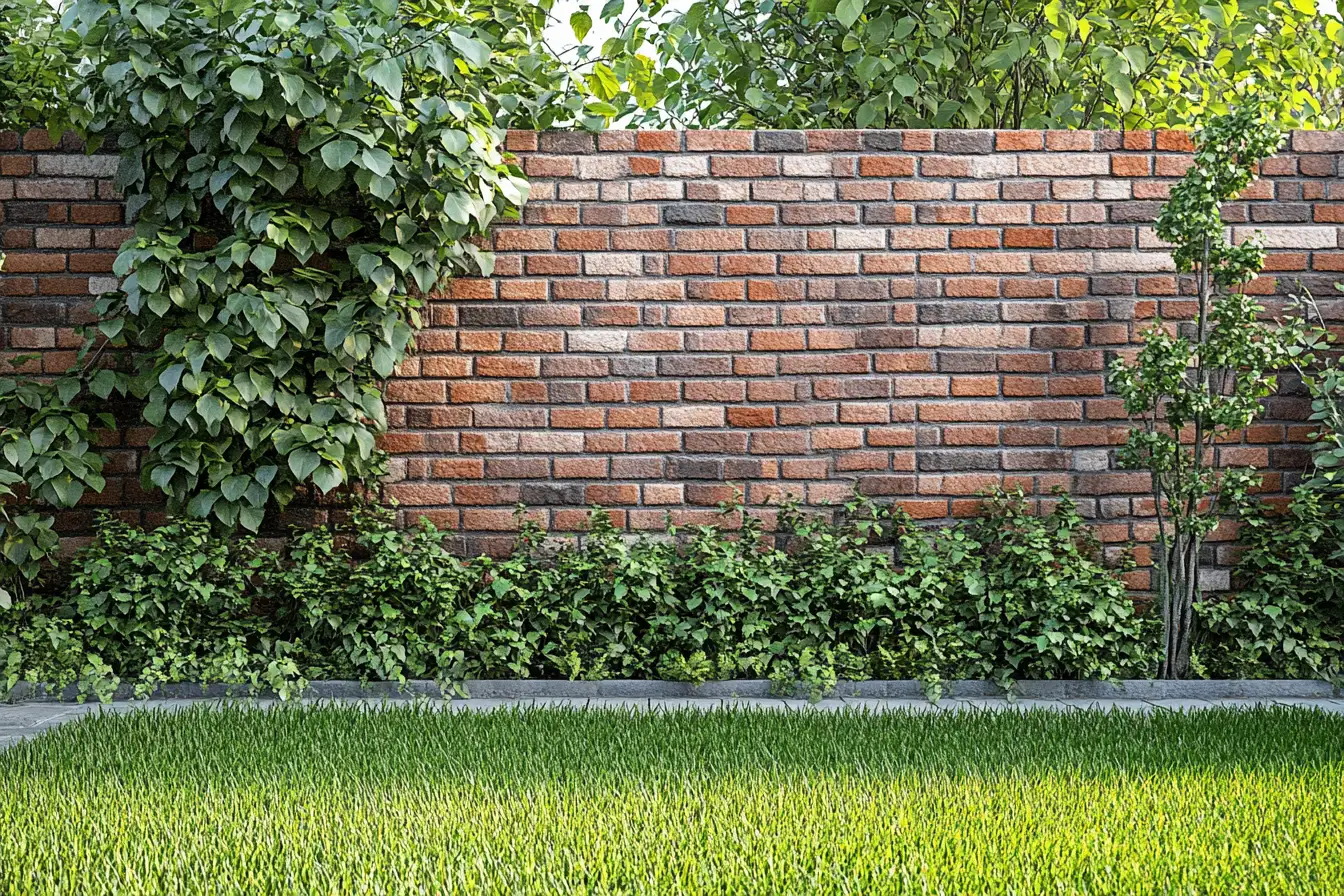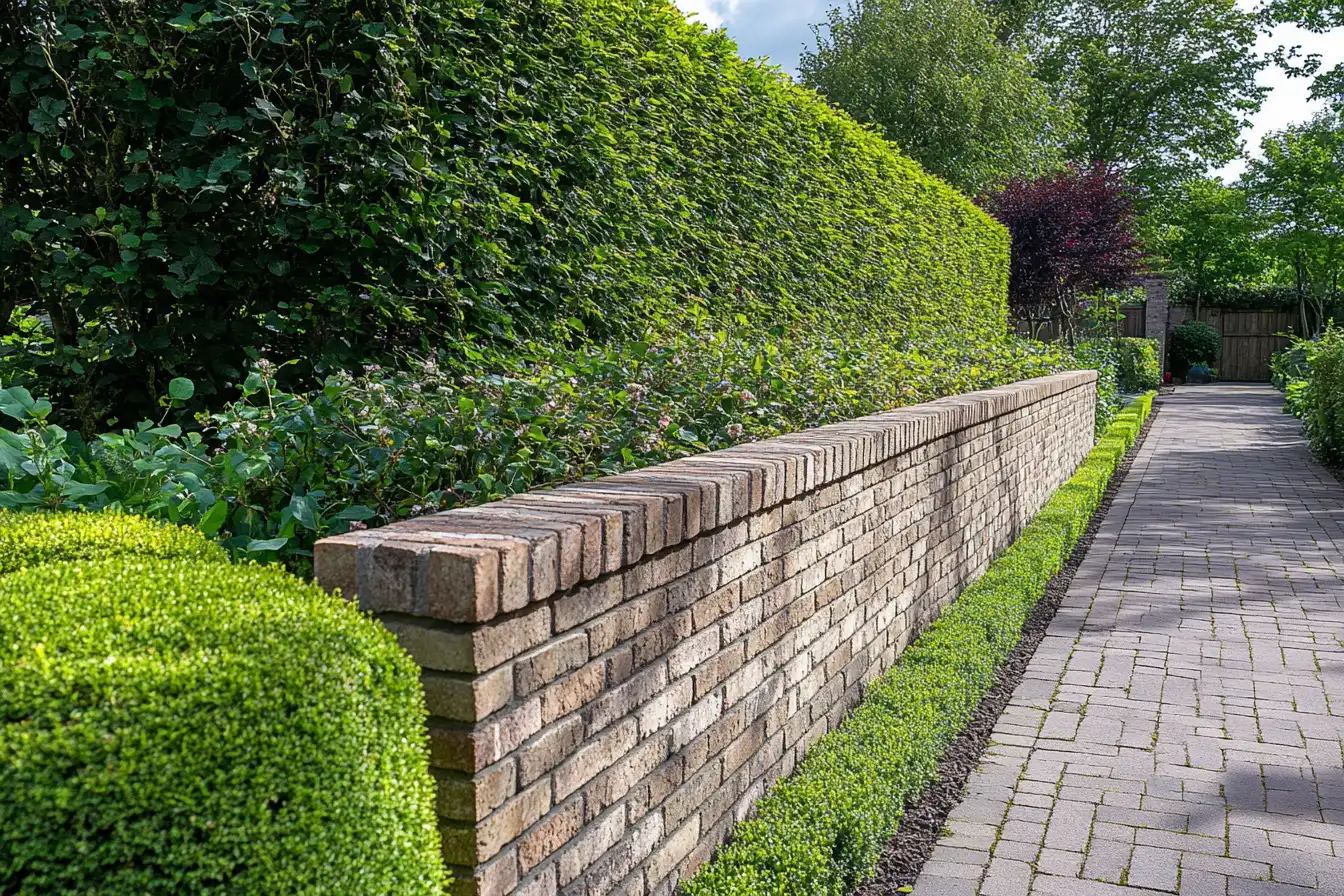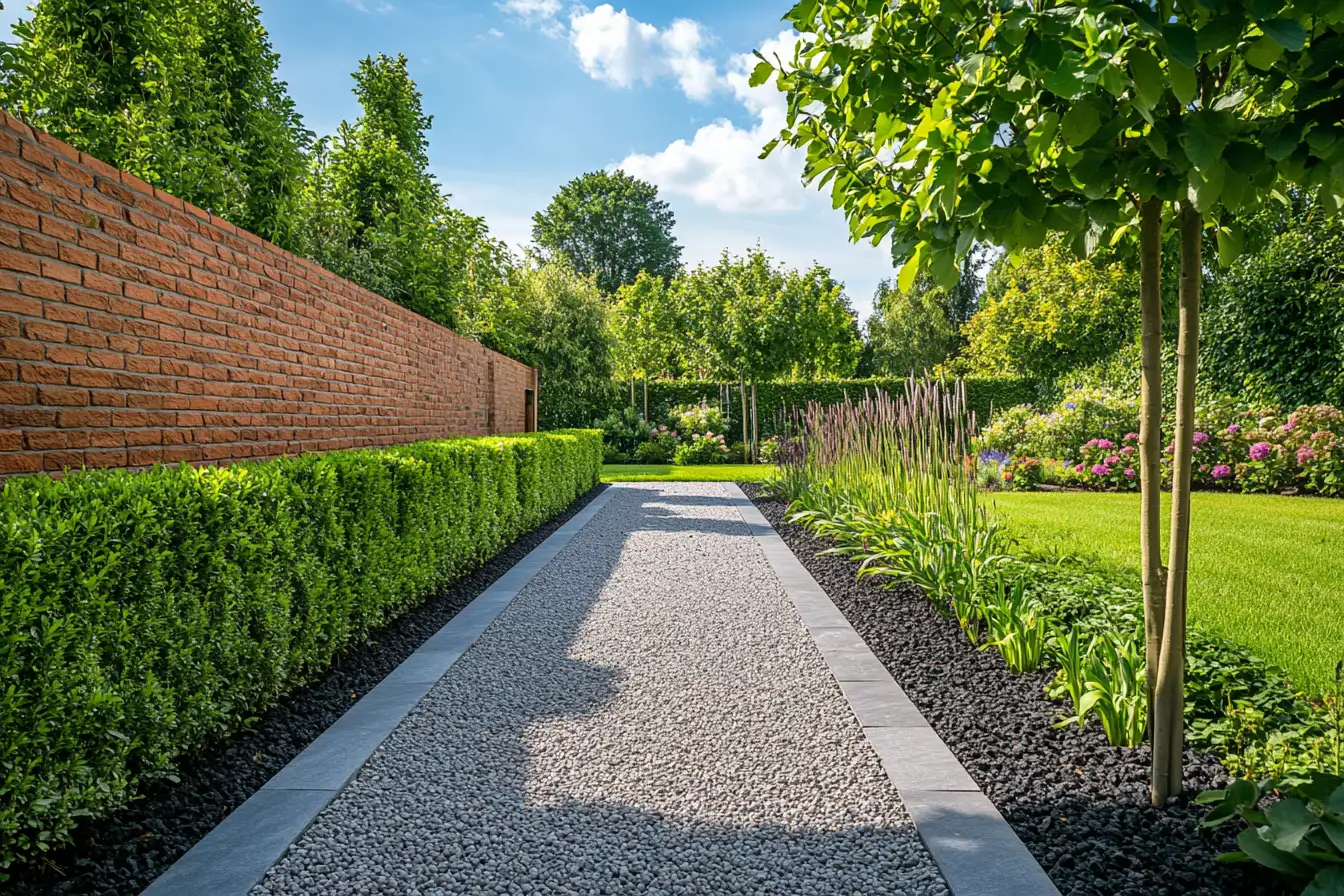Garden Brick Wall Cost: Ultimate UK Cost Guide [2025]

Thinking about adding a brick wall to your garden? I’ve recently gone through the process of building a garden wall myself and I can tell you it’s a great way to improve privacy and the overall look of your outdoor space. But from my experience, understanding the costs involved can be a bit overwhelming. That is why I’m here to share everything you need to know about garden brick wall costs in the UK. Plus the best money-saving tips!
Key Takeaways:
- The average cost of a garden brick wall in the UK ranges from £100 to £200 per m²
- Factors affecting the price include wall height, length, brick type, and location.
- Labor costs typically fall between £150 and £300 per day
- Most bricklayers will need 3-6 days for an average sized wall
What Affects Garden Brick Wall Costs?
I’ve found that several factors influence the overall cost of building a garden brick wall:
- Wall dimensions: Height and length directly impact material and labour costs.
- Brick type: Standard bricks are cheaper than handmade or special finish bricks.
- Wall thickness: Single or double brick thickness affects material quantity.
- Foundation requirements: Deeper foundations for taller walls increase costs.
- Site accessibility: Difficult access may increase labour time and equipment needs.
- Location: Labor rates vary across the UK, with London and the South East generally being pricier.
- Additional features: Pillars, caps, or decorative elements add to the cost.
🫰 Breakdown: How Much does a Garden Brick Wall Cost in the UK?
Garden brick wall costs in the UK can vary widely based on several factors I mentioned above. On average, you can expect to pay between £100 and £200 per m² all included. Here is an overview of typical brick wall jobs:
| Size (Length x Height) | Material | Labor | Total |
|---|---|---|---|
| Small (5m x 1m) | £300 - £500 | £300 - £500 | £600 - £1,000 |
| Medium (10m x 1.5m) | £900 - £1,500 | £900 - £1,500 | £1,800 - £3,000 |
| Large (20m x 2m) | £2,400 - £4,000 | £2,400 - £4,000 | £4,800 - £8,000 |
Example: Garden Brick Wall Cost – 10 x 1.5 metres – near London
Here’s a more detailed example for a 10 m long x 1.5 m high double-skin brick wall build in the Greater London area. This example includes some extra costs which people often don’t calculate in:
| Overview | Cost |
|---|---|
| Clay Bricks | £1,000 |
| Mortar and sand | £150 |
| Foundation materials | £200 |
| Labor (4 days at £250/day) | £1,000 |
| Waste removal | £100 |
| Total Cost | £2,450 |
Material: Types of Bricks and Their Costs
The type of brick you choose significantly impacts the overall cost. Here’s a guide to different brick types and their average prices per 1,000 bricks, sorted from least to most expensive:
| Brick Type | Average Cost per 1,000 |
|---|---|
| Standard clay bricks | £350 - £550 |
| Engineering bricks | £450 - £700 |
| Reclaimed bricks | £550 - £800 |
| Handmade bricks | £850 - £1,200 |
For my garden wall, I opted for standard clay bricks, which offered a good balance of cost and appearance. They’re the most economical option, but still provide durability and a classic look. If you’re working with a tighter budget, these could be an excellent choice for your project too.
Labor Costs for Building a Garden Brick Wall
Most bricklayers charge a daily rate, which typically falls between £150 and £250. Some may offer a fixed price for the entire job. Here’s a rough guide to labor costs:
- Standard brickwork: £150 – £300 per day
- Complex or decorative brickwork: £200 – £350 per day
- Apprentice or laborer: £100 – £150 per day
On average, a skilled bricklayer can lay 400-600 bricks per day, which equates to about 4-5 metres of wall.
Additional Costs to Consider
Don’t forget these potential extra expenses when budgeting for your garden wall:
- Planning permission (if required): £200 – £400
- Decorative coping stones: £10 – £30 per linear metre
- Reinforced concrete foundation (for taller walls): £100 – £150 per cubic metre
- Painting or sealing: £10 – £20 per square metre
Btw, if you are looking for additional gardening work, you can check out my gardener prices guide.
🧱 5 Popular Types of Garden Brick Walls
Different types of brick walls offer various benefits and are suitable for different purposes. Here’s an overview of the most popular types in the UK:
- Single skin wall
- One brick thick, suitable for low walls
- Less stable but a more economical option
- Double skin wall
- Two bricks thick, more stable and durable
- Standard choice for most garden walls
- Cavity wall
- Two layers with a gap in between
- Excellent insulation, often used for extensions
- Decorative brick wall
- Incorporates patterns or uses special bricks
- Adds visual interest to your garden
- Brick and pier wall
- Incorporates stronger pillars for extra stability
- Good for longer walls or those over 1.8m high
Each type of wall has its own advantages and is suited to different garden situations. The choice depends on factors like the wall’s purpose, desired height, and your aesthetic preferences.

DIY vs Professional Garden Wall Construction: Is It Worth It?
While DIY construction can save money, I recommend professional bricklaying for most garden wall constructions. Here’s why:
- Quality: Achieving a straight, stable wall requires skill and experience.
- Speed: Professionals can complete the job much faster than a DIY attempt.
- Tools: Bricklayers have specialised tools that most homeowners don’t own.
- Safety: Improper construction can lead to unsafe walls, especially for taller structures.
- Guaranteed results: Many professionals offer warranties on their work.
The cost difference between DIY and professional construction isn’t as significant as you might think when you factor in tool hire, materials, and potential mistakes.
The Brick Wall Building Process
To help you understand what’s involved in building a garden brick wall, here’s an overview of the typical steps:
- Planning: Determine wall location, height, and style
- Ground preparation: Excavate and level the ground
- Foundation laying: Pour concrete foundation
- Brick laying: Build up the wall, ensuring it’s level and plumb
- Adding features: Incorporate pillars or decorative elements if desired
- Finishing: Apply coping stones or cap the wall
- Clean-up: Remove debris and clean brickwork
⏱️ How long does it take to build a garden brick wall?
A medium-sized wall (10m x 1.5m) can usually be built in 4-6 days. But the time required to build a garden brick wall depends on several factors:
- Wall size and complexity
- Number of bricklayers working
- Weather conditions
- Site accessibility
When I had my wall built, the professionals completed the job in about 5 days for a similar sized wall.
Tips to Keep Your Garden Wall Project on Schedule
- Ensure all materials are delivered before work begins.
- Clear the site and provide easy access for workers and materials.
- Have a contingency plan for bad weather (e.g., tarps to cover fresh brickwork).
- Be available to make quick decisions if any issues arise during construction.

How to Choose a Reliable Bricklayer
Finding a trustworthy bricklayer is crucial for a successful project. Here’s how I approached it:
- Check credentials: Look for membership in trade associations like the Federation of Master Builders or the Guild of Bricklayers.
- Read reviews: Check online ratings on platforms like Checkatrade or MyBuilder, and ask for references from previous clients.
- Get detailed quotes: Insist on written quotes that break down all costs, materials, and timelines.
- Ask about experience: Enquire about their history with garden wall projects and ask to see examples of their previous work.
- Verify insurance: Ensure they have proper liability insurance to protect you and your property.
- Clear communication: They should be able to explain their process clearly and answer your questions without hesitation.
💷 7 Tips to Reduce Your Garden Brick Wall Costs
As someone who loves a good deal, here are my top tips for saving on your garden brick wall costs:
- Compare quotes: Get at least three quotes from reputable bricklayers
- Consider reclaimed bricks: These can be cheaper and add character to your wall
- Opt for a simpler design: Complex patterns or curved walls increase labour costs
- Prepare the site yourself: Clear the area and do any necessary excavation to reduce labour costs
- Time your project: Some bricklayers offer discounts during slower seasons
- Use standard sized bricks: Custom or non-standard sizes can increase costs
- Plan carefully: Changes mid-project can be costly, so have a clear plan from the start
🌿 Environmental Considerations and Costs
Eco-friendly options for garden walls are becoming more popular. While they may have different costs, they can provide long-term benefits:
- Reclaimed bricks: Often cheaper but may require more labour to clean
- Locally-sourced materials: Can reduce transport costs and carbon footprint
- Permeable mortars: Allow water drainage, beneficial for wildlife but may cost more
- Green walls: Incorporate planting spaces, higher initial cost but adds biodiversity
While some of these options might increase upfront costs by 10-20%, they can offer long-term benefits for your garden’s ecosystem and your property’s sustainability.
FAQs
Q: How much does it cost to build a garden brick wall in the UK? A: On average, building a garden brick wall in the UK costs between £100 and £200 per square metre.
Q: How long does it take to build a garden brick wall? A: The time taken depends on the wall’s size and complexity. A professional team can typically build a 10-metre long, 1.5-metre high wall in 4-6 days.
Q: Do I need planning permission to build a garden brick wall? A: Generally, you don’t need planning permission for walls up to 2 metres high, or 1 metre if next to a road. However, it’s always best to check with your local council, especially if you live in a conservation area or a listed building.
Q: How deep should the foundations be for a garden brick wall? A: For a standard garden wall up to 1 metre high, foundations should be at least 200mm wide and 300mm deep. Taller walls require deeper foundations, typically 1/3 of the wall height.
Q: Can I build a brick wall on sloping ground? A: Yes, but it requires careful planning. The wall should be built in level sections, stepping down the slope. This is often more complex and may require professional expertise.
Q: How do I maintain my garden brick wall? A: Regular maintenance includes checking for and repointing loose mortar, cleaning off moss or algae, and ensuring proper drainage around the base of the wall. A yearly inspection can help catch issues early.
Q: What’s the difference between a single skin and double skin brick wall? A: A single skin wall is one brick thick, while a double skin wall is two bricks thick. Double skin walls are more stable and durable, making them suitable for taller or longer walls. Single skin walls are cheaper but less sturdy.
Q: What’s the difference between facing bricks and engineering bricks? A: Facing bricks are designed for their aesthetic appearance and are used for visible parts of the wall. Engineering bricks are stronger and more water-resistant, often used for foundations or damp-proof courses.
Conclusion
From my experience, balancing cost with quality pays off in the long run. The key to a successful garden brick wall lies in choosing quality materials and working with reputable professionals.
I’ve also found that the cheapest quote isn’t always the best value. Consider the bricklayer’s experience, the quality of materials used, and the long-term benefits of a well-constructed wall. Don’t hesitate to consult with professionals and get multiple quotes to ensure you’re getting the best value for your money.
With the this approach, you should end up with a beautiful, durable garden brick wall that will last for decades.
Frank is a journalist and home improvement enthusiast who recently bought and renovated his own house. After several challenges and discovering how tricky it can be to find reliable cost information, he decided to share his experiences through practical cost guides.